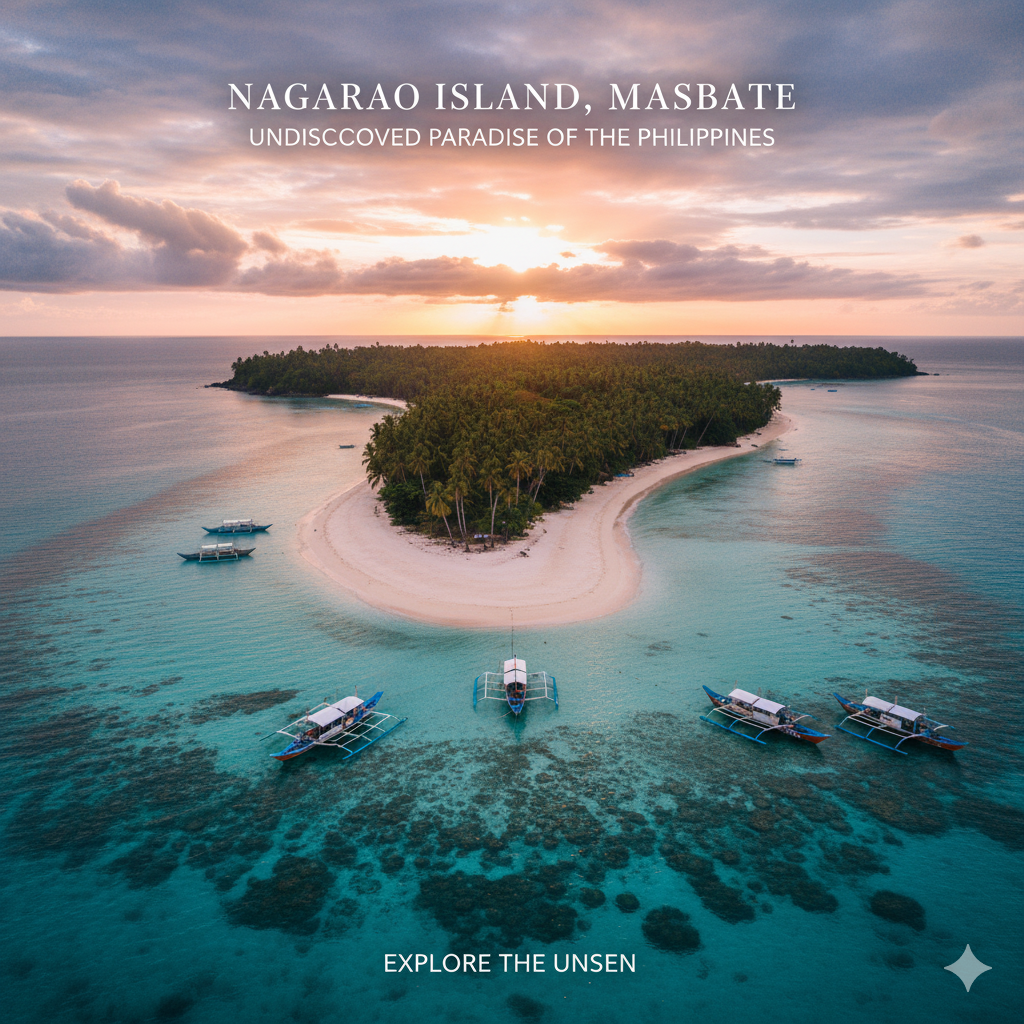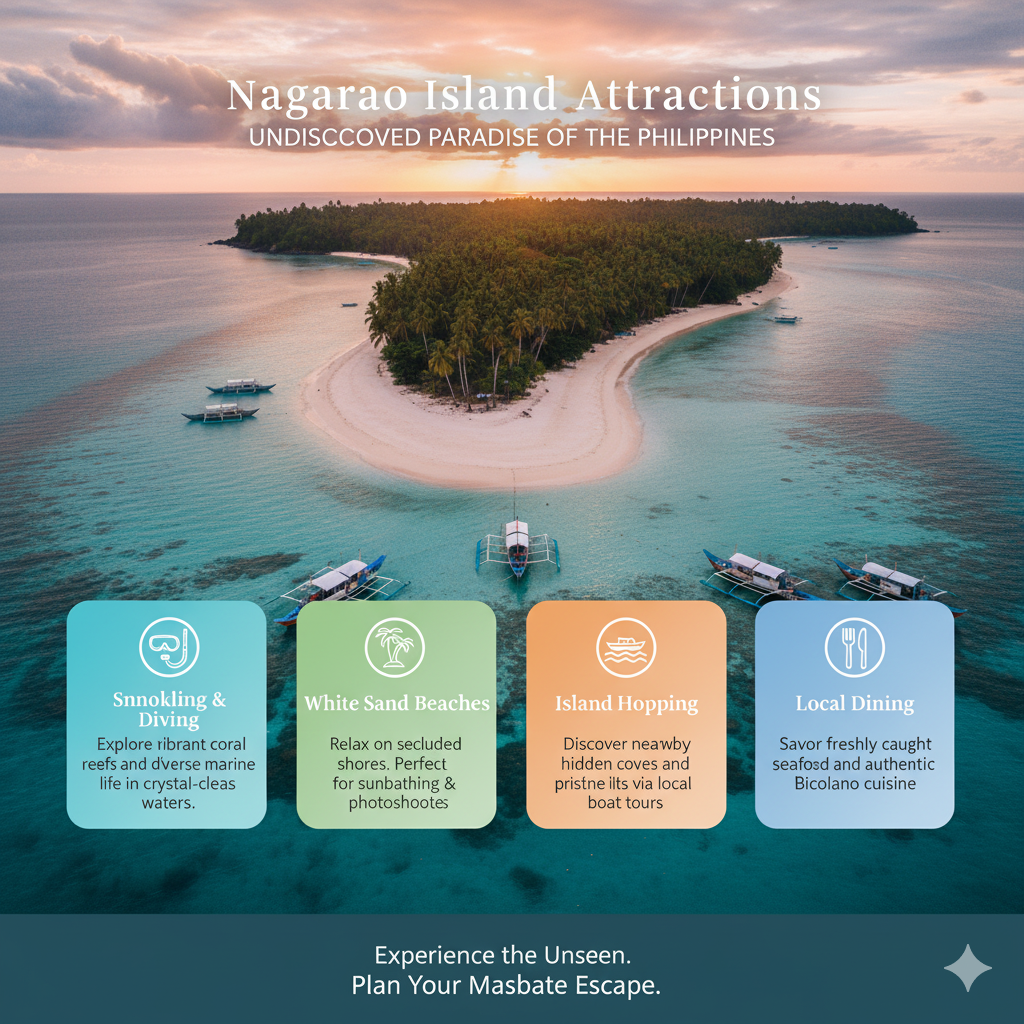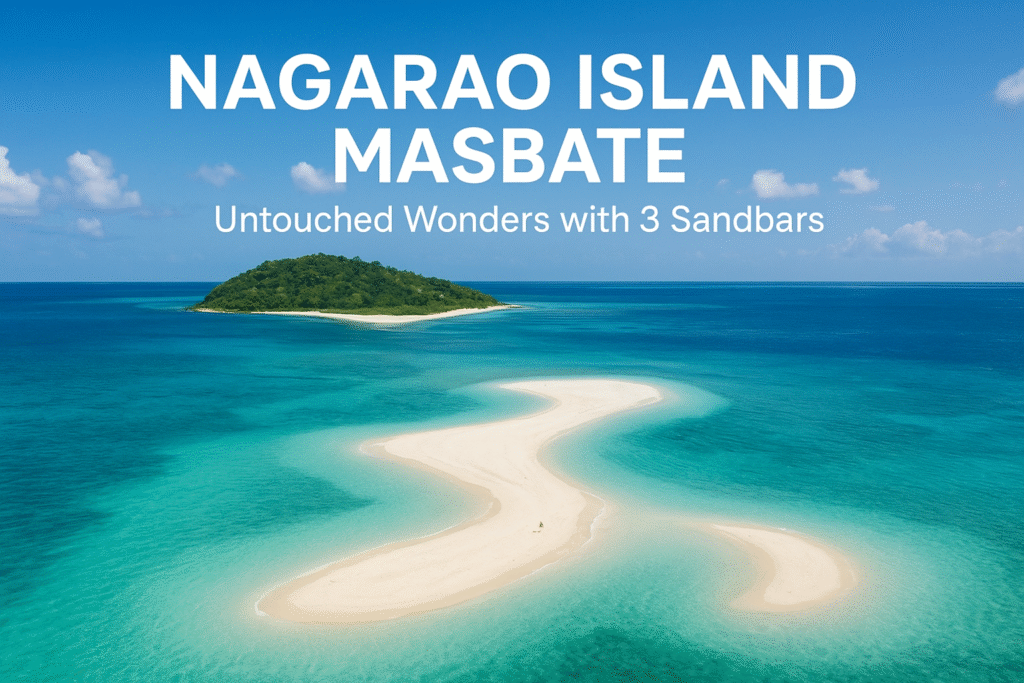Introduction: The Island Time Forgot
Nagarao Island Masbate is a hidden paradise in the Philippines, famous for its three sandbars, ecozone charm, and untouched white beaches. Tucked away in the Visayan Sea, this island feels like a fragment of the Philippines untouched by time. With powdery white sand beaches, three dazzling sandbars, and a protected ecozone, it whispers a story of nature unspoiled.
Unlike Boracay or Palawan — where the hum of tourism dominates — Nagarao moves to a different rhythm. Here, silence has a sound, sunsets paint the horizon without obstruction, and stars shine unchallenged by city lights.
📌 If you love discovering the Philippines’ hidden places, don’t miss our guide to White Island in Camiguin.
Why Visit Nagarao Island Masbate?
Nagarao lies off the coast of Masbate Province, in the Bicol Region. Despite being officially recognized as an ecozone, it has remained relatively unknown to international tourists.
Most visitors arrive through Masbate City, and from there, reach Nagarao by a boat ride from the town of Placer. Its remoteness is precisely what makes it enchanting: every traveler who steps onto its shores feels like a discoverer.

📌 Source: Masbate Province Travel Info
Things to Do in Nagarao Island Masbate
1. Three Sandbars — Nature’s Rare Gift
Most islands in the Philippines boast of a single sandbar, but Nagarao offers three distinct sandbars.
- The Crescent Sandbar curves like a natural embrace.
- The Twin-Tip Sandbar splits into two slender arms, surrounded by gentle surf.
- The Vanishing Sandbar appears only at low tide, vanishing as quickly as it reveals itself.
These aren’t just pretty stretches of sand — they are living, shifting works of art that change with the tides.
2. Ecozone Status — Protected by Law
In 1991, Nagarao Island was declared part of a special ecozone. This ensures that fishing, tourism, and development remain sustainable. Coral reefs thrive, mangroves stay intact, and marine creatures continue to flourish.
When you snorkel here, you’re swimming in an underwater sanctuary — unlike in crowded islands where reefs have been damaged.
3. Not Heavily Trafficked
Tourism in Nagarao is community-based. There are no giant hotels, no bar-lined beaches, no endless rows of souvenir stalls. Instead, you’ll find bamboo huts, family-run guesthouses, and locals who are eager to share stories.
This makes Nagarao ideal for travelers who seek authenticity over luxury.
Sandbar Hopping in Nagarao Island Masbate
1. Sandbar Hopping
Move between the island’s three sandbars as tides shift. Each has its own character — perfect for photography, barefoot walks, or just marveling at nature’s creativity.
2. Snorkeling & Diving
Colorful corals and fish thrive in Nagarao’s protected waters. The best spots are near the sandbars, where shallow reefs let even beginners enjoy vibrant marine life.
📌 Want more eco-snorkeling spots? Read about Hidden Wonders of Travel in Asia.
3. Stargazing by the Sea
At night, lie on the sandbar under skies unpolluted by city lights. Sometimes, plankton glows in the waves — a natural light show where stars meet the sea.
4. Cultural Walks with Locals
Join guided eco-tours organized by families. They’ll take you through mangroves, explain conservation practices, and share how the island balances tradition with sustainability.
5. Sunrise & Sunset Watching
Nagarao Island’s position means you can see both sunrise and sunset from the same stretch of sand — a rare double blessing for photographers.

How to Get to Nagarao Island Masbate
- Fly Manila → Masbate City (1 hour flight).
- Take a van/bus to Placer (1.5 hours).
- Hire a boat to Nagarao Island (30–45 minutes).
Getting here requires effort, but that’s exactly why it feels rewarding — every visitor becomes part of a small circle of explorers.
Where to Stay on Nagarao Island
Since Nagarao is eco-protected, accommodations are simple:
- Eco-cottages built from bamboo and nipa.
- Homestays with families cooking local dishes.
- Beach camping for travelers bringing their own tents.
If you prefer modern hotels, you can stay in Masbate City and visit Nagarao as a day trip.

Best Time to Visit Nagarao Island Masbate
- Dry Season (Nov–May): Clear skies, calm seas, sandbars at their brightest.
- Rainy Season (Jun–Oct): Expect fewer tourists but occasional rough seas.
Travel Tips for First-Timers
- Bring cash — no ATMs on the island.
- Electricity may be limited, so carry a power bank.
- Use reef-safe sunscreen to protect corals.
- Respect ecozone rules: no littering, no taking shells/corals.
- Always check tide times for sandbar visibility.
FAQs About Nagarao Island
Q1. Is Nagarao Island worth visiting?
Yes — it’s one of the Philippines’ rare untouched gems, offering peace and unique sandbars.
Q2. How many sandbars does Nagarao Island have?
It has three sandbars, each with distinct shapes and features.
Q3. Can you stay overnight?
Yes, in eco-cottages, homestays, or by camping on the beach.
Q4. Is it safe for solo travelers?
Absolutely. Locals are friendly, and since it’s a small island, crime is virtually nonexistent.
Q5. How is it different from Boracay or Palawan?
It has no large resorts, far fewer tourists, and a stronger focus on eco-tourism.
Traveler Advice: A Rare Treasure in Masbate
Nagarao Island Masbate isn’t just a travel destination. It’s a reminder of what islands once were — raw, quiet, and breathtaking. With its three sandbars, ecozone status, and authentic community feel, it offers a travel experience that most of the Philippines’ hotspots have already lost.
For those who long for wonders never seen before, Nagarao is a journey worth taking.
📌 Read more hidden gems on our blog: Hidden Wonders of Travel.



